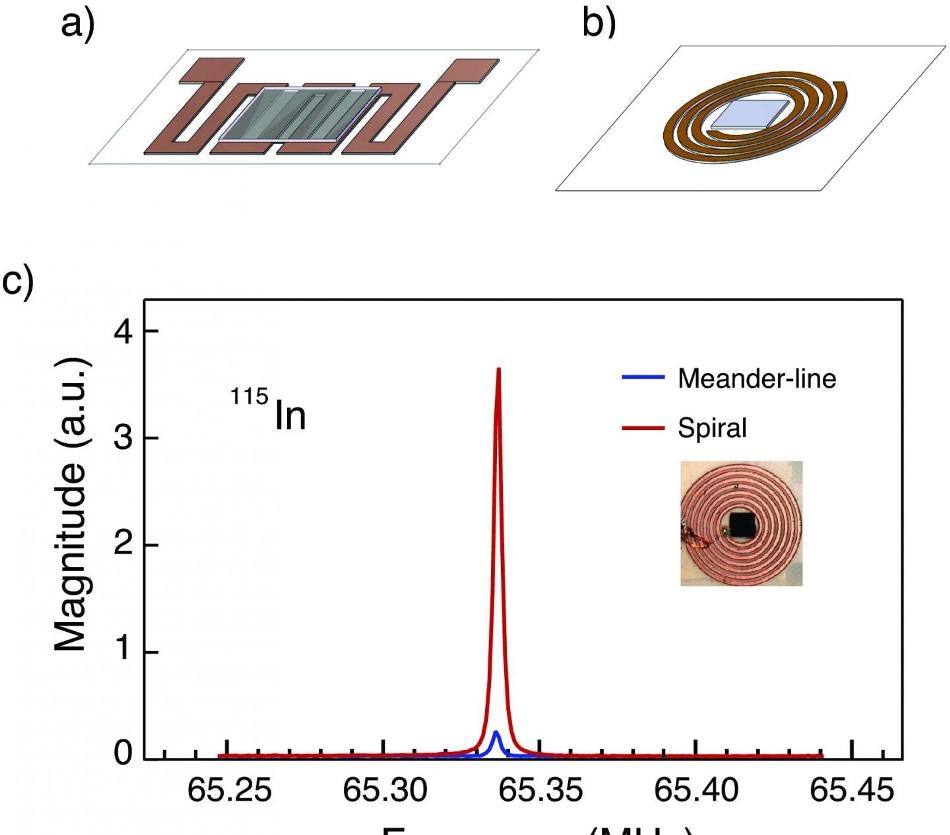Dec 20 2017
Nuclear magnetic resonance (NMR) is a robust technical tool adopted for medical imaging and for investigating the chemical structure of compounds and molecules. An innovative study conducted at Brown University demonstrates a method that assists in modifying NMR to analyze the physical characteristics of two-dimensional nanomaterials, thin films and exotic states of matter.
 Researchers have shown how flat NMR probes, as opposed to cylindrical ones, can be made useful in studying the properties of nanomaterials. CREDIT: Mitrovic lab/Brown University.
Researchers have shown how flat NMR probes, as opposed to cylindrical ones, can be made useful in studying the properties of nanomaterials. CREDIT: Mitrovic lab/Brown University.
In the technique of NMR, a strong magnetic field is applied to a sample and is then zapped with radio wave pulses. The magnetic field makes the magnetic moments, that is, “spins,” of atomic nuclei to get oriented within the sample. Based on the frequency of the radio waves, the waves tweak the spins of some of the nuclei to the opposite direction. Researchers can adopt the signal related to spin flips at varied frequencies to develop images or to ascertain the molecular structure of a sample.
“NMR is a very useful technique, but the signal you get is very weak,” stated Vesna Mitrovic, an associate professor of physics and the senior author of the paper published in Review of Scientific Instruments.
To get a usable signal, you need to detect a lot of spins, which means you need a lot of material, relatively speaking. So much of the work we’re doing now in physics is with thin films that are part of small devices or materials that have tiny crystals with odd shapes, and it’s really difficult to get an NMR signal in those cases.
Vesna Mitrovic, Associate Professor of Physics and the Senior Author of the paper
Part of the problem has to do with the geometry of the probe used to deliver the radio pulses and detect the associated signal. It's usually a solenoid, a cylindrical coil of wire inside of which the sample is placed. The NMR signal is more strong if the sample occupies majority of the space accessible within the cylinder. However, if the size of the sample is smaller than the volume of the cylinder (which is the case with nanomaterials and thin films) the signal gets weakened to almost nothing.
However, in the last few years, flat NMR coils have been used at Mitrovic’s lab at Brown University for a range of experiments striving to investigate exotic materials and unusual states of matter. Due to the fact that flat coils can be positioned directly on or very nearer to a sample, they are not affected by the signal loss in a solenoid. According to Mitrovic, although these kinds of NMR coils have been used for many years for particular applications in NMR imaging, they have not been applied in the same way as they have been used in her lab.
In this recent study, Mitrovic and her team demonstrated that apart from boosting NMR signal, flat coils of different geometries also have the potential to maximize signal for samples of distinct shapes and in various types of experiments.
For example, in experiments performed with thin films of indium phosphate, a semiconductor, the team demonstrated that tiny samples generate the strongest signal when they are positioned at the center of a circular, flat coil. In the case of larger samples, and also in experiments where it is significant to change the alignment of the external magnetic field, a meander-line shape, or a line making a sequence of right-angle turns, was found to work well.
According to Mitrovic, the potential to derive a signal at different magnetic field alignments is very significant. “There are exotic materials and interesting physical states that can only be probed with certain magnetic field orientations,” she stated. “So knowing how to optimize our probe for that is really helpful.”
One more benefit of using flat coils is that experimenters can access their sample, in contrast to leaving it confined within a solenoid.
Many of the states we’re interested in are induced by manipulating the sample—applying an electric current to it or applying a stress to it. The flat coils make it much easier to be able to do those manipulations.
Vesna Mitrovic
Mitrovic is hopeful that the guidance offered by this study on the way to optimize flat coils will be helpful for other physicists looking to use NMR to analyze exotic materials and unusual states of matter.
Wencong Liu and Lu Lu from Brown University were Mitrovic’s co-authors. A grant from the National Science Foundation (DMR-1608760) supported the study.